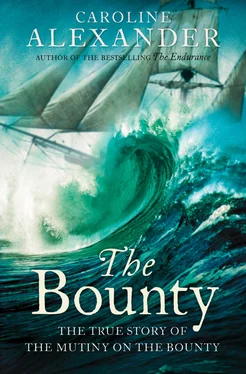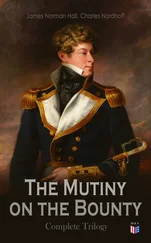Some days after the storm, Huggan, the quondam surgeon, at last succumbed to his ‘drunkenness and indolence’.
‘Exercise was a thing he could not bear an Idea of,’ Bligh wrote by way of an epitaph. Since his death had been projected even before the Bounty departed Deptford Dockyard, Huggan had a good run for his money. He was buried the following day to the east of Point Venus, across the river that cut the point and not far from the sea.
‘There the Sun rises,’ Tynah said as the grave was being dug, ‘and there it sets, and here you may bury Terronnoo, for so he was called.’ Joining Huggan’s shipmates for the funeral were all the chiefs of the region and a great many other people, respectful and solemn for the surgeon’s perhaps undeservedly dignified rites. Huggan was only the second European to be buried on the island.
It was Christmas by the time the dormant plants had put forth the desired shoots, and the men began the cumbersome task of moving camp. A reef harbour at Oparre, to the west of Matavai, had been chosen as the Bounty ’s new anchorage. With a watchful eye on the weather, which had continued to be troubled, Bligh ordered the Bounty readied for her short journey, and had his 774 potted breadfruit plants carefully carried on board. At half past ten in the morning, the ship weighed anchor and cautiously set out to follow the launch, which was carrying the tents and which Bligh had sent ahead as a pilot.
The second camp, according to Bligh, was ‘a delightful situation in every respect.’ The ship lay in sheltered, smooth water, where the tide lapped at the beach and no surf broke. Dense stands of trees shaded the new nursery, which was established along the same lines as the Matavai camp with the addition of a hut supplied by Tynah. Tynah, who had lobbied hard not to lose the Bounty and all the amusements and lucrative trade she brought, was delighted with the relocation, as he also had jurisdiction of Oparre. Taios left behind were still close enough to visit, and the easy social routine that had been enjoyed at Matavai was soon resumed, with people promenading along the beach opposite the ship ‘every fair Evening’. Bligh directed the ship ‘to be laid up and everything put below’ in part so as to avoid more thefts, but this was also a sign that the men on board could look forward to only perfunctory duties.
Nonetheless, the very day the plants and ship were safely reestablished, Bligh had William Muspratt, the cook’s assistant, flogged with a dozen lashes for ‘neglect of duty’. Two days later Robert Lamb, the butcher, was also flogged with a dozen ‘for suffering his Cleaver to be Stolen’. This now brought the total number of men punished up to six.
Although the temperature remained warm, this new season brought torrential rain and squalls, and skies so dense with sodden clouds that for an entire month Bligh was unable to take a single celestial observation. It was on one of these dark, impenetrable nights that three of the Bounty ’s men deserted. When the watch was relieved at four in the morning of 5 January 1789, Charles Churchill, the master-at-arms, John Millward, able seaman, and William Muspratt, who had only recently been flogged, were found missing. Gone with them were the small cutter along with eight stands of arms and cartouches of ammunition.
Bligh responded to the news with an icy resolve that he had hitherto not displayed. To his Tahitian friends, he stated in very clear, straightforward and polite language that he expected the men returned. Laughing nervously, they asked Bligh if he would hold them hostage on board his ship, as Cook had done. This was an unexpected and revealing question. In 1769, during his first visit to Tahiti, Cook had lost two marines to desertion and had retaliated by holding the chiefs hostage, his rationale being that his men could not survive on the island without the complicity of the islanders. That Bligh’s friends raised this concern twenty years after the event suggests that Cook’s actions had left a deep impression.
Bligh reassured his friends that he would not resort to such a stratagem, adding, in his log, that he had ‘never shown any Violence or Anger’ at any of the petty thefts that had occurred and had enjoyed such mutual goodwill that he knew his friends had confidence in him, and that he had ‘therefore no doubt but they will bring the Deserters back’ – but, if they should not, he would ‘make the whole Country Suffer for it.’ Having issued his warnings, there was little Bligh could do but wait, relying on local intelligence to flush out the fugitives.
That some of his men would try to desert probably did not take Bligh completely by surprise; again, he had his experience with Cook to draw upon. Cook had suffered desertions on Tahiti during all three of his expeditions. Recognizing that the inducements to leave ship were many, Cook had summoned his crew and lectured them at length on the ‘spirit of Desertion’, informing them that ‘they Might run off if they pleased,’ as one of the company later recorded, ‘but they might Depend upon it he would Recover them again.’ Stern as it was, the speech did not deter other, also futile attempts. Some years later, on learning of the Bounty ’s fate, James Matra, a midshipman on Cook’s first journey, would report to Banks the astonishing news that a mass desertion had been planned by ‘most of the People’ and some of the gentlemen of the Endeavour. Mr Midshipman Matra had been instrumental in dissuading them, so he would claim, his principal line of argument being that the men could be certain of ‘dying rotten’ of the pox if they were to live out their lives on the island.
Within his own company, Bligh must have seen evidence that his officers and people were settling down into Tahitian life and adopting local customs, most visibly in their passion for being tattooed. The first tattoos had arrived in England with sailors returning from the Americas or the Pacific, and especially from the Endeavour (with Joseph Banks) at the end of Cook’s first voyage, when they had become tokens of great prestige. The Bounty’s company’s tastes were varied, some sticking conservatively to English iconography. James Morrison, of all people, for reasons only to be guessed at, had had himself tattooed with the Order of the Garter around his leg and the Knights of the Garter’s motto: ‘Honi soit qui mal y pense’ – ‘Shame on him who evil thinks.’ Thomas Ellison wore simply his name and ‘October 25th 1788’ on his right arm – the date he had first sighted Otaheite.
But several of the men had undergone traditional Tahitian tattooing over large parts of their body, particularly on their buttocks. In Tahitian tradition, a man was not eligible to marry unless he had undergone the lengthy and painful operation of having his entire backside blacked over. Bligh left descriptions only of the mutineers, and with one exception (John Mills, the Scottish gunner’s mate) every one of them was tattooed, and usually ‘very much tatowed’ or ‘tatowed in several places’. Peter Heywood was in this company, being ‘very much tattowed’, among other things with the three-legged emblem of the Isle of Man. Those who had received the elaborate tattoos of Tahitian manhood included George Stewart, Matthew Quintal and Fletcher Christian.
Still, Bligh himself had encouraged friendly relations with the Tahitians, and his men’s enthusiasm for the more eye-catching aspects of their culture was not something to be readily, or fruitfully, legislated. But now, as he conducted his own grim investigation of the events, he made other discoveries. On examination of the men’s personal effects for clues, a piece of paper was found inside Charles Churchill’s chest on which he had written his own name and the names of three of the shore party. The deserters would later say darkly that ‘many others intended to remain among the islands,’ and making a list of men committed to an illegal act such as desertion – or mutiny – was an old trick. When Captain Edward Edwards, back in his happier days before he captained the Pandora , had thwarted the mutinous plot on board his ship Narcissus , a list of names of the men involved in the plot had been discovered on one of the would-be mutineers; perhaps the rash act of committing a name to paper was perceived as a kind of security that bound the man in question to one’s cause.
Читать дальше












